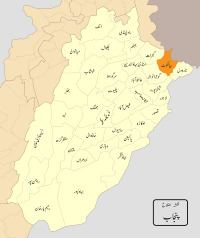Number of Tehsils 4 Area 3,016 km² | Time zone PST (UTC+5) Website www.sialkot.gov.pk | |
 | ||
Points of interest Colleges and Universities Murray College, Khawaja Muhammad Safdar M, Islam Medical College, Sialkot College of Commerce, Leadership College | ||
Sialkot District (Urdu: ضِلع سيالكوٹ), is one of the districts of the Punjab province of Pakistan. It is located in the north-east of the province. The city of Sialkot is the capital of the district. It is the third richest city in Pakistan. In sialkot cantonment was established in 1852.
Contents
- Map of Sialkot District Pakistan
- Administration
- History
- Geography
- Demographics
- Historical figures
- Military
- Journalists and poets
- Politicians
- Nazim
- Scientist
- Artists
- Sportsmen
- Others
- References
Map of Sialkot District, Pakistan
Administration
The district is administratively divided into the following four tehsils (subdivisions), which contain a total of 122 Union Councils:
History
Sialkot District was agricultural region with forests during the Indus Valley Civilization. The Vedic period is characterized by Indo-Aryan culture that flourished in Punjab region. The Kambojas, Daradas, Kaikayas, Madras, Pauravas, Yaudheyas, Malavas and Kurus invaded, settled and ruled ancient Punjab region. After overrunning the Achaemenid Empire in 331 BCE, Alexander marched into present-day Punjab region with an army of 50,000. The Sialkot was ruled by Maurya Empire, Indo-Greek kingdom, Kushan Empire, Gupta Empire, White Huns, Kushano-Hephthalites and Shahi kingdoms.
In 997 CE, Sultan Mahmud Ghaznavi, took over the Ghaznavid dynasty empire established by his father, Sultan Sebuktegin, In 1005 he conquered the Shahis in Kabul in 1005, and followed it by the conquests of Punjab region. The Delhi Sultanate and later Mughal Empire ruled the region.
The legendary history of the District is connected with Raja Salivahan, the reputed founder of the town of Sialkot, and his famous son Rasalu. Pasrur is also an ancient place. At an early date the District fell to the Rajas of Jammu, and under the Mughals formed the Rechna Doab sarkar of the Subah of Lahore. Under Shah Jahan the sarkar was entrusted to Ali Mardan Khan, the famous engineer, who dug a canal through it to bring water from the Chenab river to the imperial gardens in Lahore. On the decline of the Mughal empire Ranjit Singh Deo, a Rajput hill chief, extended his sway over the lowlands, owning a nominal allegiance to Delhi. In 1748 he transferred his allegiance to Ahmad Shah Durrani, who added Zafarwal and two other parganas to his fief. Before his death in 1773 Ranjit Deo had secured possession of the whole District, except the Sialkot town and its dependencies, which were held by a Pashtun family.
During the Indian Rebellion of 1857 the station was denuded of British troops; and the Native regiments which were left behind rose, and, after sacking the jail, treasury, and courthouse, and massacring several of the European inhabitants, marched off towards Delhi, only to be destroyed by Nicholson at Trimmu Ghat. The rest of the Europeans took refuge in the fort, and on the morning after the departure of the rebels order was restored. The only events of interest in the subsequent history of the District are the plague riots which occurred at the villages of Shahzada and Sankhatra in 1901.
Numerous mounds are scattered about the District, which marks the sites of ancient villages and towns. None of them, except that on which the Sialkot fort stood, has been excavated, but silver and copper utensils and coins have been dug up from time to time by villagers. Most of the coins are those of Indo-Bactrian kings. The excavations in Sialkot revealed the existence of some old baths, with hot-water pipes of solid masonry. The fort itself, of which very little now remains, is not more than 1,ooo years old, and is said to have been rebuilt by Shahab-ud-din Ghori at the end of the twelfth century.
In 1859, Gurdaspur, Amritsar and Sialkot were placed in the new division of Sialkot. But in 1884, Gurdaspur along with Amritsar again became a part of the Lahore Division.
According to the 1901 census, the district had a population of 1,083,909 and contained 7 towns and 2,348 villages. The population at previous three enumerations were: 1,004,695 (1868), 1,012,148 (1881) and 1,119,847 (1891). The population decreased between 1891-1901 by 3.2, the decrease being greatest in the Raya tahsil and least in Daska. The Chenab Colony was responsible for this fall in population, no less than 103,000 persons having left to take land in the newly irrigated tracts.
The district was subdivided into five tehsils namely: Sialkot, Pasrur, Zafarwal, Raya and Daska, the headquarters of each being at the place from which it is named. The chief towns of the district were Sialkot, Daska, Jamki, Pasrur, Kila Sobha Singh, Zafarwal and Narowal.
In 1930, the tehsils of Raya, Daska and Pasrur were split up and parts of these were amalgamated into Gujranwala District. In 1991, the tehsils of Narowal and Shakar Garh (which was tehsil Shankar Garh of Gurdaspur district before the independence of Pakistan in 1947) were split up and formed into the new Narowal District.
Geography
Sialkot District lies southeast of Gujrat District, southwest of Jammu district, while Narowal District is to the southeast and Gujranwala District is situated to the west.
Sialkot district is spread over an area of 3,016 square kilometers
Sialkot is hot and humid during the summer and cold during the winter. June and July are the hottest months. The maximum temperature during winter may drop to -2 °C. The land is generally plain and fertile. The average annual rainfall is about 1000 mm. Over 25.82% of the population of the district is urban.
Demographics
The predominant language of the district is Punjabi, which according to the 1998 census is the first language of 97% of the population, while Urdu accounts for 1.5%.
